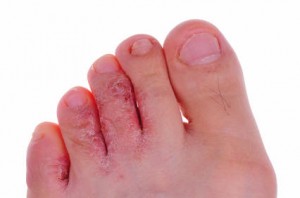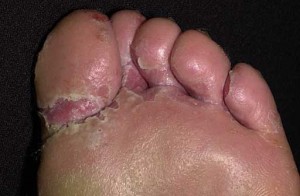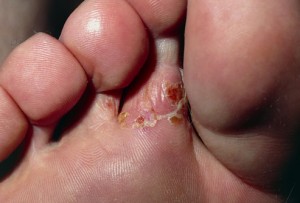Tinea Pedis is a common condition that is characterized by inflammation and flaking of the feet. Know all about the causes, symptoms, diagnosis, treatment and preventive measures of this disease. There are also some useful Tinea Pedis photos that you may look at for reference.
What Is Tinea Pedis?
Page Contents
- 1 What Is Tinea Pedis?
- 2 Symptoms of Tinea Pedis
- 3 What Causes Tinea Pedis Infection?
- 4 Tinea Pedis Diagnosis
- 5 Tinea Pedis Treatment
- 6 Tinea Pedis Home Remedy
- 7 Tinea Pedis Risk Factors
- 8 Is Tinea Pedis Contagious?
- 9 Tinea Pedis Prognosis
- 10 Tinea Pedis Complications
- 11 Tinea Pedis Prevention
- 12 Pictures of Athlete’s Foot (Tinea Pedis)
It is a disease caused by fungal infection of the feet. The medical term “Tinea Pedis” literally means “ringworm of the feet”. The infection generally affects the feet but may spread to other parts of the body such as the groin.

Picture 1 – Tinea Pedis
Source – your-lifestyleonline
The condition is also known as “Athlete’s Foot” or “Tinea of the foot”. Other medical terms for this condition are Interdigitalis, Dermatophytosis Palmaris and Plantaris. The name “Interdigitalis” indicates that the condition may also affect the palms of hands other than the toes and soles of feet.
Symptoms of Tinea Pedis
Some of the main symptoms of Tinea Pedis are
- Scales or flakes on feet
- Cracks or blisters over skin of feet
- Itching and burning sensation in a localized region
- Redness and inflammation of the toe
- Exposure of raw tissue
- Peeling of skin in a particular area
These symptoms can arise in the toes as well in other regions of the body such as palms, heels and in the spaces between the fingers.
The condition may also lead to the thickening, crumbling and discoloration of the nails. This generally happens if the fungus spreads to the nails.
What Causes Tinea Pedis Infection?
The human body consists of a large number of microbes, such as fungi and bacteria. Some of these are beneficial to the physical system and may assist in bodily functions, such as the intestinal bacteria. Athlete’s Foot occurs when there is a rapid multiplication of a certain kind of fungus in the body. The fungus grows especially between the toes. In some cases, there may also be an overgrowth of fungus in the hands.
Athlete’s Foot is the most common type of fungal infection that is popularly known as Tinea infection. The condition is commonly caused by the dermatophyte Trichophyton rubrum.
Tinea Pedis Diagnosis
The diagnosis of Tinea Pedis is mainly based on the appearance of the skin of the affected region. However, medical tests may be performed in cases where rise of many symptoms makes diagnosis difficult. Such tests include
Skin Lesion Biopsy
Biopsy involves examining a sample of Tinea Pedis blisters under the microscope. Microscopic examination helps reveal presence of fungus in the sample. This proves a fungal infection of the region.
Skin Culture
In this process, skin scrapings are collected and examined under a microscope. If fungus is present, testing may help show it.
KOH Examination
Scrapings of skin lesions are collected and examined to detect presence of fungus.
Tinea Pedis Treatment
The treatment of Tinea Pedis involves use of antifungal creams and powders that are available over-the-counter. These usually contain tolnaftate, clotrimazole and miconazole. The medicine should be continued for one to two weeks even after the infection has resolved. Continued use prevents recurrence of the infection.
Acute infection of the foot does not go away with over the counter cure or home remedies. In case of severe infections that persist for two to four weeks, stronger treatment is needed. Antifungal medicines such as topical drugs like Terbinafine or Ketoconazole may be used for Athlete’s Foot treatment. If secondary bacterial infections arise along with fungal attack, as commonly happens due to scratching the infected region, antibiotics may be used in treatment for Tinea Pedis.
Tinea Pedis Home Remedy
Some of the common Tinea Pedis home remedies are
Cleanliness of feet
Moist feet increase chance of fungal infection. Keeping the feet dry and clean can make you recover faster from this infectious condition. Regularly wash your feet with soap and water. Do not wear socks or shoes immediately after bathing. Allow your feet time to dry before putting on shoes.
Avoid tight fitting clothes
Avoid using socks and clothes that are tight for your body. Tight garments and socks refuse air drying of sweat and a moist body provides the perfect environment for fungal growth.
Tinea Pedis Risk Factors
The fungus typically affects people who walk barefoot in moist areas. It can also infect a person in bathhouses and showers. People who do not dry their feet well or wear tight-fitting trainers commonly suffer from this problem. Walking barefoot over wet, warm surfaces such as locker room floors and shower stalls can increase chances of catching this infection.
Diabetics and people with weakened immunity are also susceptible to this disorder.
Is Tinea Pedis Contagious?
Athlete’s Foot is an extremely contagious condition. Once a person has been infected by Trichophyton fungus, he or she can easily transmit it to another person.
Tinea Pedis Prognosis
Mild cases of the condition respond well to treatment and usually last only for a short time. Severe cases can take a longer time to resolve. Preventive measures as well as long-term medical care are required to cure persisting cases of Athlete’s Foot. In the absence of care, the infection may persist or come back after some time.
Tinea Pedis Complications
Some of the possible complications that this condition may produce include
- Recurrence of the infection
- Lymphadenitis
- Secondary bacterial infections like Cellulitis
- Chronic Tinea Pedis
Use of medications for treatment of this disease may also give rise to complicated side effects.
Tinea Pedis Prevention
This discomforting syndrome can be avoided by following these simple preventive measures.
Drying the feet
Allowing air-drying of feet after swimming or bathing can be effective in keeping fungal infection at bay.
Wearing sandals
Wearing flip-flops or sandals at public pools or showers can avoid fungal infection of the toe. Microbial organisms like bacteria and fungus are usually common in public areas.
Use antifungal powders
Sprinkle drying or antifungal powders on the toes and soles of your feet before putting on shoes or immediately after coming back from a public shower or pool.
Pictures of Athlete’s Foot (Tinea Pedis)
Want to get a visual idea about the appearance of the condition? Here are some useful pictures of Tinea Pedis. Check out these Tinea Pedis images to know how a foot affected with this disorder looks like.

Picture 2 – Tinea Pedis Image
Source – dartmouth

Picture 3 – Tinea Pedis Photo
Source – boots
With proper care and effective medical cure, there is excellent prognosis of Tinea Pedis. If you notice redness and inflammation of your feet and find them warm to touch, contact a doctor immediately. Early diagnosis and treatment will help you make a faster recovery from this disease.
References:
http://www.nlm.nih.gov/medlineplus/ency/article/000875.htm
http://www.netdoctor.co.uk/diseases/facts/athletesfoot.htm
http://en.wikipedia.org/wiki/Athlete%27s_foot
http://emedicine.medscape.com/article/1091684-overview
http://www.umm.edu/ency/article/000875.htm
